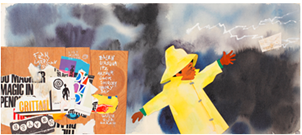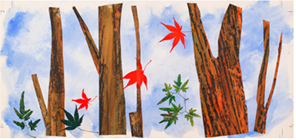 Published at the height of the American civil-rights movement and winner of the prestigious Caldecott Medal, The Snowy Day became a milestone, featuring the first African-American protagonist in a modern full-color picture book. The Snowy Day went on to inspire generations of readers, and paved the way for multiracial representations in American children's literature. Also pioneering were the urban settings of Keats's stories; picture books had rarely featured such gritty landscapes before.
Published at the height of the American civil-rights movement and winner of the prestigious Caldecott Medal, The Snowy Day became a milestone, featuring the first African-American protagonist in a modern full-color picture book. The Snowy Day went on to inspire generations of readers, and paved the way for multiracial representations in American children's literature. Also pioneering were the urban settings of Keats's stories; picture books had rarely featured such gritty landscapes before. Organized by The Jewish Museum in New York City, the exhibition features more than 80 original works - from preliminary sketches and dummy books, to final paintings and collages for the artist's most popular books. Also on view are examples of Keats's most introspective but less-known work, inspired by Asian art and haiku poetry, as well as documentary material and photographs.
Ezra Jack Keats was born Jacob (Jack) Ezra Katz in Brooklyn in 1916. His parents were Eastern European Jewish immigrants and very poor. Although he briefly studied painting in Paris on the GI Bill after serving in World War II, Keats was primarily self-taught. He drew upon memories of growing up in East New York, one of the most deprived neighborhoods of New York City. Keats's experience of anti-Semitism and poverty in his youth gave him a lifelong sympathy for others who suffered prejudice and want. His work transcends the personal and reflects the universal concerns of children.

Keats used lush color in his paintings and collages and strove for simplicity in his texts. He was often more intent on capturing a mood than developing a plot. His preferred format was the horizontal double-page spread, which freed him to alternate close-up scenes with panoramic views. By the end of his life in 1983, he had illustrated over eighty books, most of them for children, twenty-two of which he also authored.
The introductory gallery presents a selection of works that can be construed as self-portraits of the artist. Throughout his career Keats often cast himself in his work, posing as different characters, from the immigrant violinist János in Penny Tunes and Princesses (1972) to the exuberant junkman Barney in Louie's Search (1980).
"Coming of Age in Brooklyn" features seminal works inspired by memories of Keats's tenement childhood, including a selection of illustrations for Apt. 3 (1971) showcasing some of his most painterly spreads. Also on view are final drawings for Dreams (1974), where color travels out of the Brooklyn windows and into the night as the tenement's inhabitants begin to dream and darkness turns into incandescence. Keats's combination of paint and marbled paper reaches a pinnacle in these illustrations. The artist's lengthy preoccupation with Louie, protagonist of some of Keats's most autobiographic stories, is examined in this section through a series of illustrations for Louie (1975), The Trip (1978), Louie's Search (1980), and Regards to the Man in the Moon (1981).
In "Bringing the Background to the Foreground," the artist's early identification with the downtrodden is reflected in his 1934 award-winning painting, Shantytown. Created by Keats during the Depression, it is being shown along with other socially committed works. In order to express the significance of The Snowy Day within the history of American children's literature, an exhibition case is devoted to a brief survey of African-American representation in children's books throughout the 20th century. Illustrations for My Dog is Lost! (1960), coauthored by Keats and Pat Cherr, about a Puerto Rican boy named Juanito, are also on display. This is Keats's first attempt to correct the problems of representation in children's literature at the time and cast a minority child as protagonist. This pioneering move likely paved the way for his creation of Peter of The Snowy Day fame.
"The Snowy Day" section presents a wide selection of illustrations for the 1962 landmark book as well as for Whistle for Willie (1964) and Peter's Chair (1967), featuring Peter as he grows up. The Snowy Day's critical reception and the debate sparked by its publication are also examined.
"Peter's Neighborhood" includes a rich selection of images for three of Keats's greatly loved books: A Letter to Amy (1968), Hi Cat! (1970) and Pet Show! (1972), featuring Peter on his way to becoming a teenage boy, as well as his friend Archie, who takes on more of a central role as Peter grows older. The selected illustrations are filled with Keats's signature elements - abandoned old doors, overflowing garbage cans, trashed umbrellas, and graffitied walls; the background elements the artist was committed to bringing to the foreground in his books. A reading room for visitors of all ages inspired by Peter's neighborhood and Brooklyn tenement brownstone stoops, complements this section.

Exhibition Catalogue
In conjunction with the exhibition, The Jewish Museum and Yale University Press co-published The Snowy Day and the Art of Ezra Jack Keats.The 104-page catalogue includes 80 color and 3 black-and-white illustrations, essays by Claudia Nahson and Maurice Berger, and an illustrated timeline by Emily Casden and Ms. Nahson. The hardcover book will be available at the Museum Store for $32.00 and online at www.judaicashop.net.
Sponsorship
The Snowy Day and The Art of Ezra Jack Keats is organized by The Jewish Museum from the collection of the de Grummond Children's Literature Collection, The University of Southern Mississippi. The exhibition is funded through a generous grant from the Ezra Jack Keats Foundation. Additional support has been provided by the Joseph Alexander Foundation, the Alfred J. Grunebaum Memorial Fund, and the Winnick Family Foundation.
Related Programs
Tuesdays, July 2, 9, and 16 - 10:30-12:00 pm
Illustrating Childhood: The History of Children's Book Illustration in the United States
-- Instructor: Mary F. Zawadzki Ph.D. Candidate
-- Over the course of three sessions, the Illustrating Childhood course will review the history of children's book illustration from the nineteenth century through the present, surveying a broad spectrum of stylistic and socio-cultural developments.
August 4 - A Snowy Day in August: Keats Family Day
-- Hourly 11:00 to 4:00 - Storytelling/reading
-- 10:30 am and 1:30 pm - Screenings of animated films of Keats's books including The Snowy Day, Whistle for Willie, Peter's Chair, Pet Show!, A Letter to Amy, The Trip, and Apt. 3.
-- 1:00 pm - How to Build a Storm: The Weather Show, presented by The Franklin Institute.
-- Various arts and crafts activities throughout the Museum, including book-making, hat decorating, and puppet making.
The Museum will also hold several programs in collaboration with the Rosenbach of the Free Library of Philadelphia Foundation, which will be celebrating the 50th anniversary of Maurice Sendak's Where the Wild Things Are with The Night Max Wore His Wolf Suit: 50 Years of Wild Things from June 11, 2013 through March 2, 2014. Those programs are as follows:
September 8 - Grandparents Day
-- Grandparents and kids are admitted free of charge to NMAJH and The Rosenbach!
-- Screenings of animated Keats and Sendak books including Where the Wild Things Are, In the Night Kitchen,
The Nutshell Kids, Alligators All Around, One was Johnny, Pierre,Chicken Soup with Rice,The Snowy Day, Whistle for Willie, Peter's Chair, Pet Show!, A Letter to Amy, The Trip, and Apt. 3
-- Various arts and crafts activities throughout the Museum
-- Docent-led conversations, guided tours, and spotlight talks
October 13
-- 11:00 am Tell Them Anything You Want: A Portrait of Maurice Sendak film screening
Talkback to follow
-- 2:00 pm Where the Wild Things Are film screening
Both screenings are FREE with Museum admission
October 16 - 7:00 pm Panel discussion: Children's Literature and Social Justice
No comments:
Post a Comment